#Limnology
Text

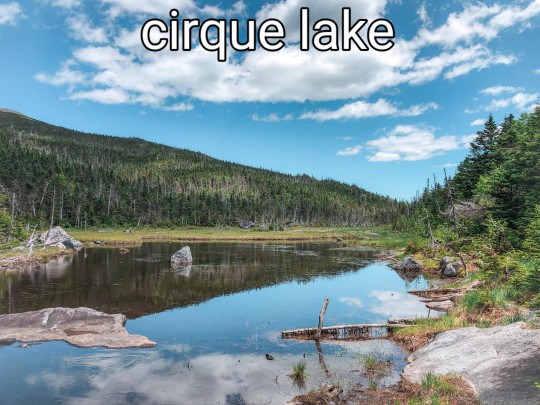
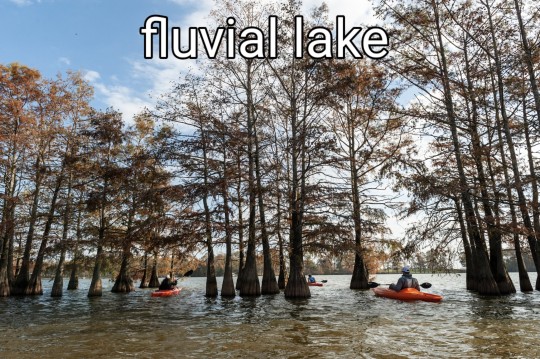

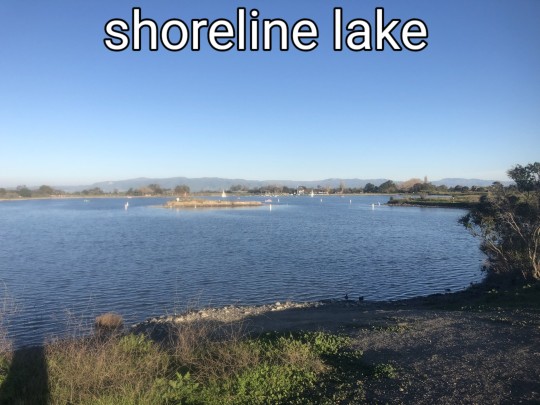
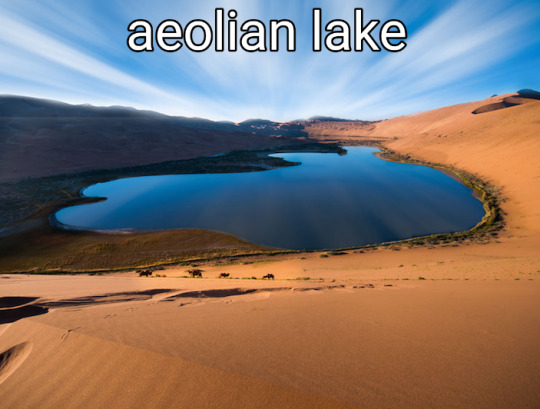




#lakes#lakeposting#poll#geology#geomorphology#nature#lake#naturecore#beautiful#limnology#science#ecology#aquatic ecology#water#meteor#meteorite#volcanic#glacier#glacial#tectonic#earth#environment#environmental science
2K notes
·
View notes
Text
We Need to Talk About Your Rivers
The “rule of cool” is a common piece of advice for artists. Let your imagination run wild. And that applies to fantasy as well. By its very nature, rules are meant to be broken. It’s part of the mystique. It’s why the genre can be so compelling. But to really break the rules effectively, it helps to have a solid comprehension of the underlying contexts. The rule of cool can backfire when we push…

View On WordPress
#canals#deltas#estuaries#limnology#map making#river systems#rivers#stream orders#water#world building
3 notes
·
View notes
Text
rn im majoring in forestry with a focus in forest biology, but might want to switch to aquatic biology. this is a ridiculously important thing to be asking on tumblr but i cannot even begin to decide. both would be super fucking interesting and have the same number of required credits
pros and cons below the cut
pros:
get to work with wetlands more
still doing stuff with plants and animals
the program is centered on freshwater conservation which i really like
was thinking of doing a water resources minor anyway, this would be easier to get all the credits
electives for both are super flexible so i could really focus on what interests me
watershed conservation is generally better paying than forestry
better to prepare for a ms in limnology
could stay in the greater great lakes region long-term
cons:
calculus i and ii
organic chemistry i and ii
i really fucking hate math
generally harder classes
might not go for an ms anyway
#college#studyblr#bachelors degree#undergraduate#bachelor of science#environmental science#environmental studies#environmetalists#ecology#forestry#forest tech#epa#forest service#aquatic science#wildlife and fisheries#aquatics and fisheries#fish science#limnology#freshwater fish#freshwater#great lakes#lake ontario#lake erie#lake huron#lake michigan#lake superior#new york#pennsylvania#ohio#michigan
2 notes
·
View notes
Text

This is a tiny guy called Bosmina. They are zooplankton and I find them very cool
Their eyes always make me think they've seen something beyond this mortal coil but it's just cuz they're tiny and have very rudimentary eyes. Won't stop me from posting ominously about them tho
Below the keep reading is a link to some more info on these tiny guys
9 notes
·
View notes
Text
v1.0.0 release of centerline-width is out!
A Python tool to find the centerline and width of rivers based on the latitude and longitude of the right and left banks
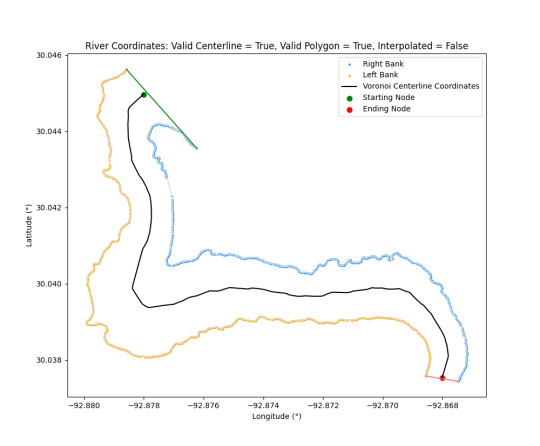

pip install centerline-width

#python#github#git#open science#river#scientific programming#research highlight#geophysics#earth science#limnology#hydrology#centerline#centerline extraction#river bank
2 notes
·
View notes
Text
Starfish are carnivores and latch on and pull prey into their stomach. So when I see people draw starfish on mermaid’s breasts… I just assume the worst.
2 notes
·
View notes
Text
I need a mycologist to collaborate with me on underwater hyphae/ arbuscular mycrorhizae/ macrophyte water filters. Where do I find the underwater mushroom people?
#mycology#biology#botany#liminology#water#filter#science#mushroom#please#mycrorhizae#reblog#help me find them#limnology
7 notes
·
View notes
Text
What I wouldn't GIVE to have a lateral line to not only make me look cooler but to aid my spatial awareness 😫
#*bangs head on table* I WISH I WERE A FISH#fish#lateral line#icthyology#limnology#fisheries and wildlife science#biology
5 notes
·
View notes
Text

I took myself out to a solo date for the first time in 5 years and to something I've always been curious about. My dad has always taken me fishing, but I think fly fishing, specifically the art that goes into tying flies is intriguing. Fly fishers wax poetic about communing with nature. Many, like myself, catch and release fish while recording data for conservation. They are quite beautiful creatures, and I enjoy the beauty of their habitat and colorful mosaic of scales. Most excitingly, I saw a handful of other women there. I swear there were dozens of us! Dozens!
#fly fishing#angler#trout fishing#fishing#conservation#catch and release#outdoorsy#Girls who fish#wildlife#biology#Limnology#Habitat conservation
0 notes
Text

𝐄𝐜𝐨𝐥𝐨𝐠𝐲: Marine ecologists study the interactions between organisms and their environment. They may study how organisms compete for resources, how they interact with each other, and how they are affected by changes in the environment.
𝐄𝐯𝐨𝐥𝐮𝐭𝐢𝐨𝐧: Marine evolutionary biologists study the history of life in the ocean. They may study how marine organisms have evolved over time and how they are related to other organisms.
Visit: https://symbiosisonlinepublishing.com/marine-biology-research/
#marinebiology#marinebiologist#ecology#evolution#marineecology#fishfarm#fishfarming#Echinodermata#fisherieseconomics#fisheriesmanagement#aquaticdiseases#limnology#oceanography#fishgenetics#pathology#fishbiochemistry#aquaculturebiotechnology#aquaculture#marineresearch#Research#researchstudy#pubmed#peerreview#peerreviewed#OpenAccess#journals#journal#openaccessjournal#casereport#symbiosisonlinepublishing
1 note
·
View note
Text
Zooplankton are tiny crustaceans that occupy a variety of roles in Great Lakes food webs, from open water filter feeding to benthic decomposers 🩵
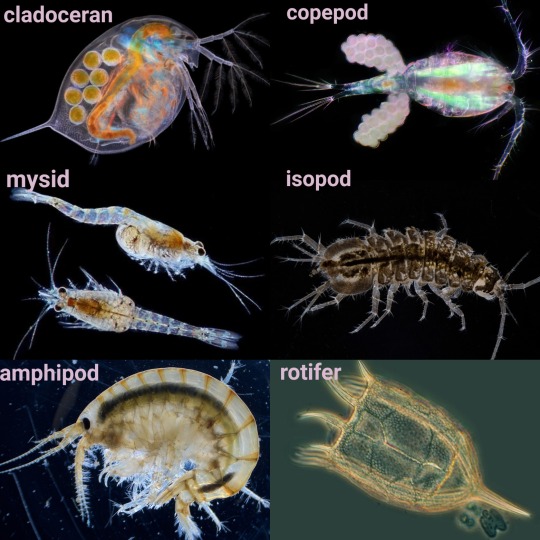
#great lakes#lakeposting#poll#lake#freshwater#freshwater ecology#aquatic ecology#ecology#biology#science#crustaceans#cute#animals#shrimp#freshwater science#limnology#aquatic#plankton#zooplankton#cladocerans#copepods#amphipods#isopods#rotifers#food web#nature#naturecore#microscopic#miniature
476 notes
·
View notes
Text
Dr Thomas Townley Macan’s 1960s “Freshwater Ecology” is kinda fun. The book begins by chewing out ecologists who tunnel vision on a small specialism because ecology is So Complex and you can’t really divide things into microcosms because they interact so often and in so many ways (some unknown). I agree in this sense but also like you can’t have a super deep knowledge of Everything so there are limits here. continuing the eff-you, the book starts with a table of contents that promises a distinct lack of tunnel-vision-on-a-specialism, covering as much as possible about limnology (study of inland water bodies, so mostly like rivers and lakes and stuff).

kind of a fighting spirit for someone whose nickname was, apparently, “Kitten”...
The bulk of the book is text with some really tidy diagrams and goes over some cool concepts that are pretty core in limnology. That being the effect of water which can be highly varied in its qualities. Of course this book was written in 1963 so it is Not Up To Date but a decent amount holds water... freshwater, you might say.
Anyways... Here’s a whirlwind tour of Fun Limnology things.
The speed of water flow (river, versus lake, versus rapids, versus pond...) dramatically affects life within. Faster water can move heavier substrate, so faster water leads to a deficit of fine sediment. Also, fewer things live free-swimming in fast water because of how energetically demanding it would be to swim against the current to stay in one spot. you see a lot of bugs and stuff which anchor themselves to rocks in these spots.

here we have a moraine/fluvial deposit which only exists in the area without a steep slope, as the fast-flowing water over the steep bits washes smaller particles away.

the current speed and resulting substrate differences lead to some species, such as those which can cling to rocks using an assortment of mechanisms, which can include hook like legs, or byssal threads (shown below, though note that the image is of an intertidal species, though the function is the same)

Fast currents can be beneficial though, as the flow mixes oxygen into the water and can carry food along with it. e.g. the spiny-gilled mayfly traps food in its leg bristles as the water flows past.

Another thing which impacts freshwater systems is, of course, water temperature, which is something that people think about a lot due to climate change. Water temperature is interesting as shade cover is tied into this, and that’s a complicated subject. Of course rivers have been extensively deforested but also there are rivers and lakes wide enough that no matter how forested the banks are, there will be a sunnier bit in the middle. temperature rises from deforestation are because of increased sunniness, which also allows for phytoplankton to bloom. This makes the water more turbid (”cloudy”) and can result in species that prefer to eat algae to overtake species that prefer to eat leaves and stuff that fall into the river.
(side note, “allochthonous” organic matter (OM) refers to OM that originates outside of the river and falls in, like leaves and sticks and dead bugs. Conversely “autochthonous” OM means algae and stuff that originates from inside the river).
There is a (somewhat debated) idea of the “river continuum theory” where rivers follow a trend of starting narrow, fast, cold, and shaded, and slowly becoming slower, wider, and sunnier. So what we see with deforestation, maybe, is the stuff that likes narrow and cold rivers getting pushed out by those that like slower and wider rivers.
back to temperature, temperature impacts oxygen availability to aquatic things, with hotter water holding less oxygen. You can guess why that is not a good thing.
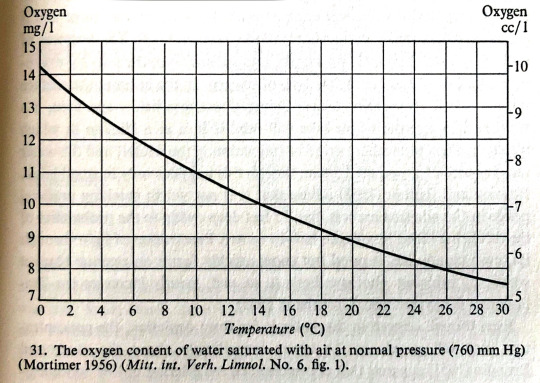
This is compounded by animals’ oxygen consumption going Up in hotter water. Not 100% of the time but in general.

Water temperature (actually, just temperature in general) can also affect maturation rates for a whole range of invertebrates. Hotter =/= faster as every species has its “ideal” temperature and there is a point where they’ll just be getting cooked, but the figure below in Macan’s book shows how dramatically invertebrate maturation can change with temperature. Basically look from time=0 to the final curved line, and that’s the total hours it took to get to adulthood.

the last thing limnology-y is salinity. This part always gets me because (as Macan was critiquing) people like to specialise in “freshwater bio” or “marine bio” which leaves estuaries in a funky limbo. There are definitely people really invested in estuaries but historically a lot of scientists were like, Eh, too salty to be freshwater, too fresh to be marine, so neither freshwater nor marine biologists can study this ig. apparently. im an estuary lover boy so I wouldn’t know.
Anyways as freshwater approaches flowing into the ocean, salinity changes a Lot. and this can cause big issues for animals, for example in saltwater they need to make sure they don’t dehydrate via their gills. It can be really really tough to move between salinities. So you can get things like this:
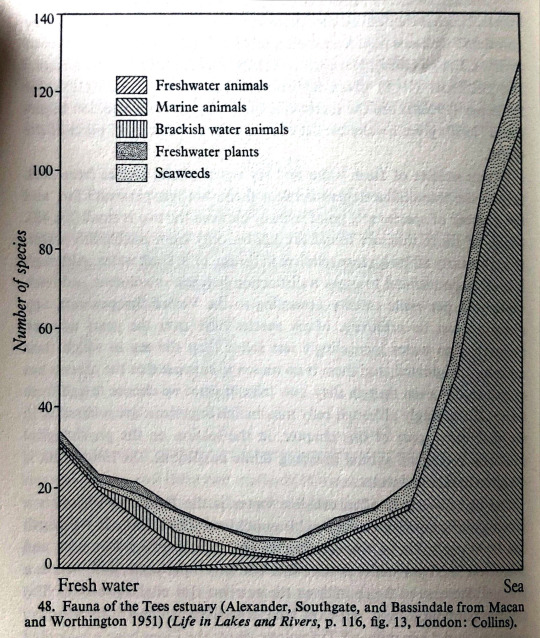
where certain things live in certain salinities along an estuary and not in others. But there Are things that move between salinities and have to cope with that using various dramatic techniques. I kind of hate the comparative anatomy of kidneys though so I will save this for another time.
You can also get things that can survive a range of salinities but have preferences (e.g., preferring lower salinity) structuring their territories around salinity, such as crocodiles. That paper is on American crocodiles in Costa Rica, and I found a blog called “Los peces mas hermosos del mundo” (the most beautiful fish in the world); this is an amazing blog title so I had to include it, and also it had this Costa Rican American crocodile picture.
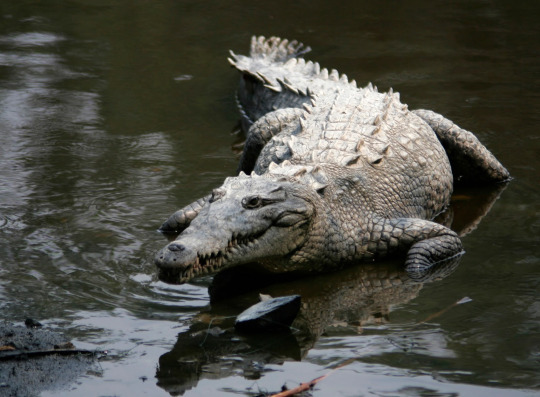
Look at them, they Are one of the most beautiful fish in the world!
anyways that was limnology power hour, please send freshwater/inland water bodies some love, theyre so underrated :[
#biology#zoology#ecology#marine biology#limnology#freshwater biology#estuary#fish#invertebrates#crocodile#science#sciblr#old books#books#bivalves#inverts#miaow#osedax bookblog
0 notes
Text


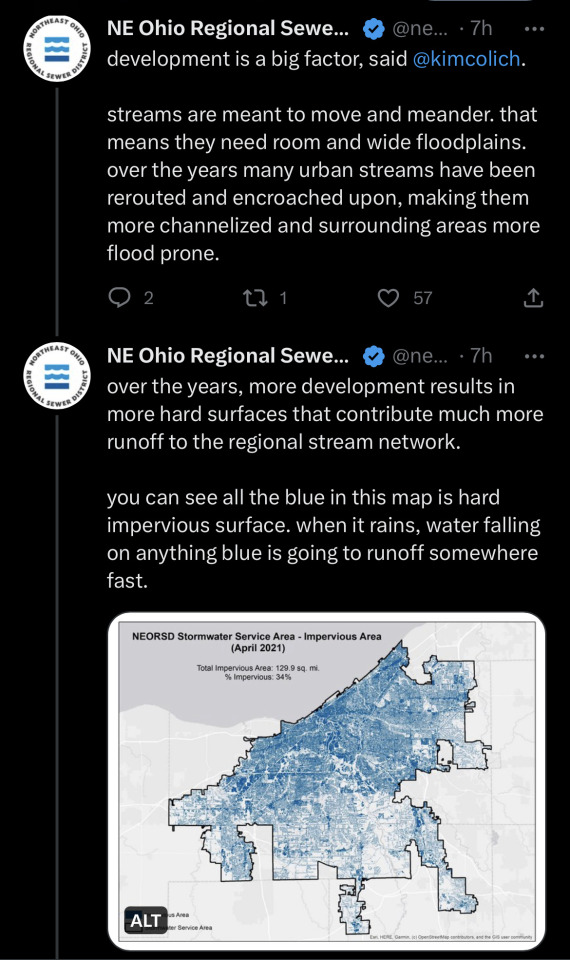



this actually calmed me down, it really did
0 notes
Text
Nutrient content of fresh water river system sediment from 90s until now. Or any span of time to notice trends.
0 notes
Photo

In 1986, a mysterious white mist spewed from Lake Nyos, Africa, tragically killing 1,746 people and 3,500 cattle over night. But what caused this ‘limnic eruption’? Read on here: https://fishwaterandtravel.com/nyos-the-african-lake-disaster/. #naturaldisaster #disaster #mystery #limnology #biology #volcano https://www.instagram.com/p/Ciuknoyu1hy/?igshid=NGJjMDIxMWI=
0 notes
Text
Effect of Salinity Stress on Growth, Yield and Quality of Roses: A Review
Abstract
Soil salinity is one of the most important abiotic factors that adversely effect on plant growth. In addition, nursery and greenhouse industry is under pressure to recover and recycle fertilizer solution and wastes. Most of these contains significantly higher salt concentrations that could cause harm to susceptible species of plants. Rose plants are the most attractive plants in all our world. Although, the roses face serious salt stress. Globally, soil salinity is naturally occurring or by the usage of poor quality of water and the other activities of humans or use of excessive amount of fertilizer applications. Although, the level of salts tolerance among various cultivars and species can be different in roses. In this review paper, we will discuss the responses of roses to salinity and ways to combat salinity in roses production.
Read More about this Article: https://juniperpublishers.com/ijesnr/IJESNR.MS.ID.556155.php
Read More Juniper Publishers Google Scholar: Read More about this Article:Read More Juniper Publishers Google Scholar:
#Juniper Publishers Google Scholar#Juniper Publishers group#climatology#Geo Morphology#limnology#environment and natural resources#soil loss
0 notes